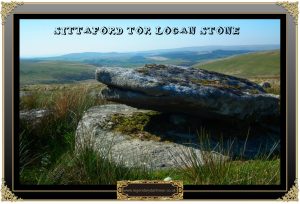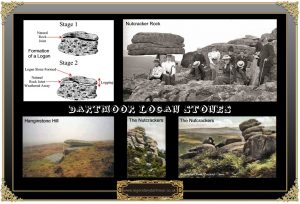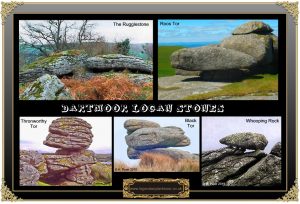
“Thither, youths,
Turn your astonish’d eyes; behold yon huge
And unhewn sphere of living adamant,
Which, poised by magic, rests its central weight
On yonder pointed rock: firm as it seems,
Such is the strange and virtuous property,
It moves obsequious to the gentlest touch
Of him whose breath is pure; but to a traitor,
Though even a giant’s prowess nerved his arm…”
Caractacus – Mason
On many of Dartmoor’s tors are what are known as Logan Stones and I have included them in the Ancient Monuments section because even though they are a natural feature there is a train of thought that says the stones were also of some ritual significance. What is a Logan Stone or rock? Hemery, p.61, succinctly describes them as being: ” A rock which, through weathering, has become disjoined from the parent-rock and is pivoted upon it… Such rocks can be ‘logged’, set in motion without fear of their over balancing.” In other words, a logan is formed when a joint in a granite rock is eroded by the weather until it gets to a point when enough weathering has taken place to leave the stone balanced on a small pivot which enables the stone to rock or ‘logg’, as show in the diagram below. Logged is another Devonshire word for rocked and it has been suggested that it is this word that has mutated to Logan, i.e.. Loggin’ Stone – Logan Stone. In the 1930s The Oxford Dictionary of Place-Names found a different interpretation by suggesting that the village of Belstone had derives its name from Bell Stone which they then stated that a ‘Bell Stone’ was another term for a logan stone as it rocked like a bell.
Some of the more famous logan stones are the Hanging Stone on Hangingstone Hill, The Rugglestone at Widecombe-in-the- Moor, The Nutcrackers on Sharpitor in Lustleigh Cleave (which is marked on the OS map as being a logan stone), the Nutcracker Rock on Rippon tor which again is marked as a logan stone on the map, albeit wrongly called the ‘Nut Crackers’, Black tor logan, Whooping Rock on Easdon Tor and one on Shilstone tor. There are also numerous other smaller logans on many of the other tors and you can have hours of childish fun rocking back and forth on them. It is slightly disconcerting when without realising it you stand on one and suddenly find your balancing skills put to the test. The more noted of these logan stones became popular destinations for visitors desirous of seeing a ‘mythical’ rocking stone. Some would even take nuts with them and attempt the crack them by putting them under the stone and ‘logging’ it. Just one of many reports of such comes from 1887 when a local choir had their annual outing and visited the huge logan by the river Teign in Fingle Glen. It was remarked that; “a rugged path by the riverside brought the party to the celebrated Logan Stone. This natural curiosity having been admired and its nut cracking properties tested for the benefit of those who had secured nuts along the way, the party returned to the village for tea.” – The Exeter & Plymouth Gazette, August 16th, 1887. With the advent of Dartmoor charabanc tours from the late 1800s to early 1900s many of the itineraries included either stopping or driving past the logan stone of Rippon Tor, probably because it was visible or accessible from the nearby road.
Many writers have suggested that the logan stones were used by the Druids in their various rites and rituals. Imagine how awesome it could have been to see a venerated priest moving several tons of granite with his finger if you did not know he was rocking a logan stone. It is hardly likely that the prehistoric people knew how the rock was formed and so it would have been regarded as some magical power to be able to move these huge granite boulders.
Sadly over the years many of the larger logans have lost their ability to rock, this in a couple of cases has be due to acts of vandalism. There was a great debate a few decades ago when the Nutcrackers on Sharpitor was vandalised and then after several attempts restored by the army. The controversy was whether they replaced the original rock, either way it did not ‘logg’ anymore. The Hanging Stone on Hangingstone Hill was also restored by the army in 1966 when it was reported that they had found the centre of gravity and the stone rocked once more. It obviously has moved since because it no longer rocks and rolls:

Hemery, E. 1983. High Dartmoor. London; Hale
 Legendary Dartmoor The many aspects past and present of Dartmoor
Legendary Dartmoor The many aspects past and present of Dartmoor




2 comments
Pingback: Excuse me, But Do You Log? | Dartmoor Hiking
Pingback: Black Tor and Hart Tor - Dartmoor Walks - Rocking Chair Fuel